Cooling fans in medical displays are noisy and prone to failure. This noise distracts clinicians, while a fan failure can halt critical procedures. Fanless designs eliminate these problems entirely.
A fanless cooling design uses passive thermal management instead of mechanical fans. This approach enhances reliability, reduces noise, and improves hygiene, making it essential for modern clinical environments.
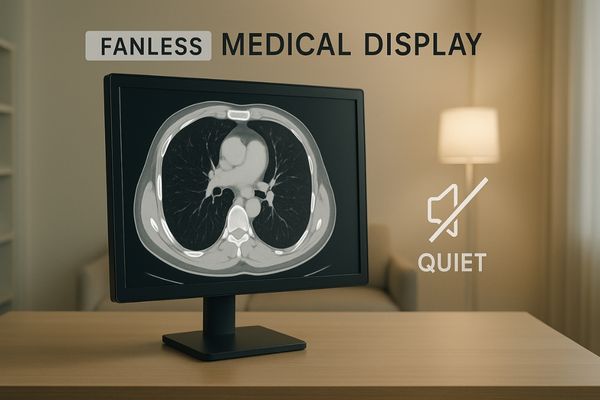
This technology represents a significant step forward in medical device engineering1. It directly addresses the core needs of a demanding healthcare setting. We will now explore the specific advantages of adopting a fanless design2 for medical displays.
Fanless Design Reduces Noise in Medical Environments
The constant hum of cooling fans creates background noise. This noise can break a clinician’s concentration during important tasks. A fanless display ensures a quiet, focused workspace.
A fanless cooling system eliminates the mechanical noise produced by medical displays. This creates a quieter environment, which is essential for clinician concentration in sensitive areas like operating rooms and diagnostic reading rooms.

Noise is a significant environmental stressor in hospitals. In a diagnostic reading room, a radiologist must maintain intense focus for hours to detect subtle abnormalities in images. Background noise from equipment can contribute to cognitive fatigue and increase the risk of errors. In an operating room, clear communication between team members is critical for patient safety. The mechanical whir of multiple fans can interfere with verbal commands and auditory alerts from other vital equipment. Fanless designs solve this problem by dissipating heat silently through passive means, such as convection. This creates a more serene and effective clinical environment. The MD26GA – 2MP Diagnostic Monitor3 is built with this principle in mind. Its fanless architecture ensures it operates in complete silence, allowing for undisturbed concentration during long and detailed image reviews.
Passive Cooling Enhances Display Reliability
Mechanical fans contain moving parts that can wear out. When a fan fails, the display can overheat and shut down unexpectedly. Passive cooling systems have no moving parts, ensuring continuous, stable operation.
Passive cooling eliminates moving parts like fans, which are prone to failure. This design significantly increases the display’s mechanical reliability and ensures stable, uninterrupted performance during critical medical procedures.
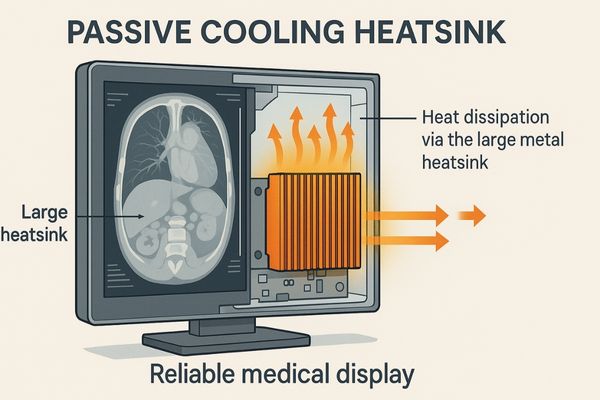
Reliability is not a luxury in medical equipment; it is a necessity. The most common point of mechanical failure in many electronic devices is the cooling fan. Its bearings can wear out, or its motor can burn out, especially after years of continuous operation. If a display’s fan fails during a complex surgery, the unit could overheat and shut down, jeopardizing the procedure. Passive cooling systems are inherently more reliable. They use a combination of specially designed metal chassis and internal heat sinks to draw heat away from critical components. This heat is then dissipated into the surrounding air through natural convection. Because there are no moving parts, the risk of mechanical failure is eliminated. Our MS550P – 55" 4K Surgical Monitor, which is used in demanding surgical environments, relies on an advanced passive cooling system. This robust design ensures it can operate for extended periods without the risk of a fan-related failure.
| Feature | Fan-Based Cooling | Fanless Passive Cooling |
|---|---|---|
| Moving Parts | Yes (Fan motor, bearings) | No |
| Noise Level | Audible (25-40 dB) | Silent (0 dB) |
| Failure Point | Mechanical fan failure | None (solid-state) |
| Dust Intake | High | None (sealed design) |
| Reliability | Lower | Higher |
Dust-Free Operation Benefits Sterile Settings
Cooling fans actively pull air into a device. This air carries dust, microbes, and other airborne particles. A sealed, fanless design prevents this contamination, protecting sterile environments.
A fanless design allows for a completely sealed enclosure. This prevents the intake and circulation of dust, microbes, and other airborne contaminants, which is critical for maintaining sterile operating rooms and cleanrooms.
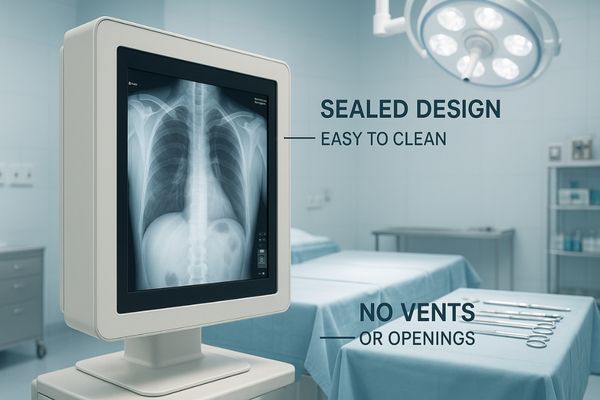
Infection control is a top priority in healthcare, especially in operating rooms and other sterile environments. Equipment with cooling fans acts like a small vacuum cleaner, constantly drawing in airborne contaminants. These particles can accumulate inside the device and then be expelled back into the room, compromising the sterile field. A fanless design4 allows the display to be completely sealed. With no need for air vents, the internal electronics are protected from the outside environment. This dust-free operation is crucial for maintaining sterility. It also makes the display far easier to clean and disinfect. The smooth, sealed surfaces have no grilles or vents where pathogens can hide. The MS270P – 27" FHD Surgical Display is engineered with a fully sealed, fanless chassis. This design not only supports strict infection control protocols5 but also allows it to withstand frequent cleaning with harsh medical-grade disinfectants without risking damage to the internal components.
Thermal Management Impacts Display Longevity
Excessive heat is a primary cause of electronic failure. Inefficient cooling shortens a display’s lifespan and reduces its value. Effective thermal management protects the device and the hospital’s investment.
Efficient thermal management is key to protecting sensitive internal components from heat damage. A well-designed fanless system dissipates heat effectively, extending the display’s operational lifespan and maximizing its return on investment.
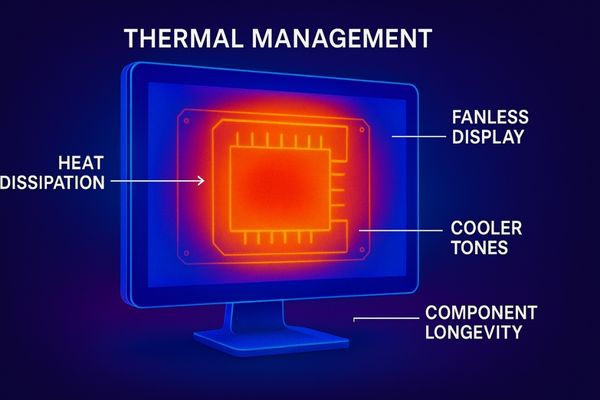
Every electronic component has an optimal operating temperature range6. When components like the main processor, power supply, or the LED backlight run too hot for too long, their performance degrades and their lifespan is significantly reduced. This is a critical factor in the total cost of ownership for a medical display. A well-engineered fanless system is not just about being silent; it is about being effective. It requires careful design using materials with high thermal conductivity and large surface areas to radiate heat away from the electronics. This keeps the internal temperature stable and within safe limits, even when the display is operating at high brightness for many hours. By preventing heat-related degradation, superior thermal management7 ensures the display maintains its performance and lasts longer. The MD46C – Dual-screen Diagnostic Monitor (Single Panel) is built for longevity. Its advanced passive thermal solution is designed to protect its dual-panel system, ensuring a long and reliable service life in high-use radiology departments.
| Component | Optimal Temperature | Impact of Overheating |
|---|---|---|
| LED Backlight | < 50°C | Reduced brightness, color shift, shorter lifespan |
| LCD Panel | < 60°C | Image sticking, permanent pixel damage |
| Processor | < 85°C | Performance throttling, system instability, failure |
| Capacitors | < 105°C | Reduced lifespan (halved for every 10°C increase) |
Fanless Technology Aligns with Modern OR Standards
Modern operating rooms require advanced, integrated equipment. This equipment must be quiet, reliable, and hygienic. Fan-based systems no longer meet these high standards, making fanless technology the new benchmark.
Fanless design directly supports the key requirements of modern operating rooms: low noise, high reliability, and strict infection control. This technology has become a de facto standard for high-quality, next-generation surgical equipment.
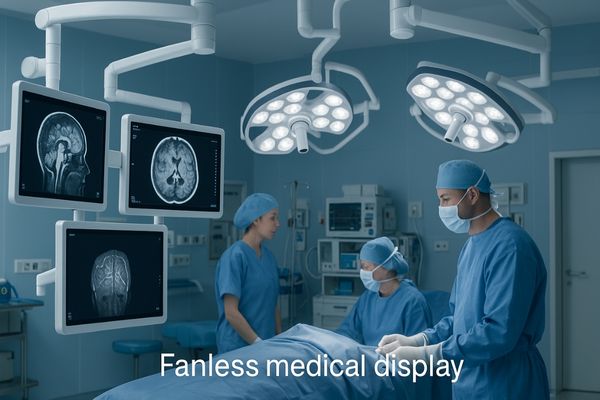
The operating room of today is a highly sophisticated environment. Surgical teams rely on a suite of interconnected technologies, and displays are at the center of this ecosystem. As minimally invasive procedures become more common, the dependence on crystal-clear, reliable video feeds increases. The standards for all equipment in this space have evolved. Low noise is required for communication. High reliability is non-negotiable for patient safety. Strict hygiene is essential for infection control. Fanless technology addresses all three of these core requirements in a single design philosophy. It is quieter, has fewer failure points, and is easier to keep sterile. For this reason, it is no longer just a feature but a fundamental expectation for new OR equipment. Our MS321PC – 32" 4K Surgical Monitor8 is a prime example. Its fanless design, combined with 4K resolution and a sealed housing, meets the exacting demands of the contemporary surgical suite.
Conclusion
Fanless cooling is a foundational design choice. It delivers quiet operation, superior reliability, improved hygiene, and a longer device lifespan. This technology is now essential for high-performance medical displays. To explore fanless medical displays built for demanding clinical environments, contact Reshin at martin@reshinmonitors.com.
-
Stay updated on cutting-edge innovations in medical device engineering that can transform healthcare. ↩
-
Discover how fanless designs enhance reliability and performance in medical displays, crucial for healthcare settings. ↩
-
Learn about the essential features of 2MP Diagnostic Monitors to ensure optimal performance and patient safety in medical imaging. ↩
-
Explore how a fanless design enhances infection control and equipment longevity in healthcare settings. ↩
-
Learn about effective infection control protocols to ensure safety and sterility in medical environments. ↩
-
Understanding the optimal operating temperature range is crucial for maintaining the performance and longevity of electronic components. ↩
-
Exploring superior thermal management can reveal how it enhances device performance and extends lifespan, crucial for high-demand applications. ↩
-
Discover the significance of 4K resolution in surgical monitors for improved clarity and precision during procedures. ↩


